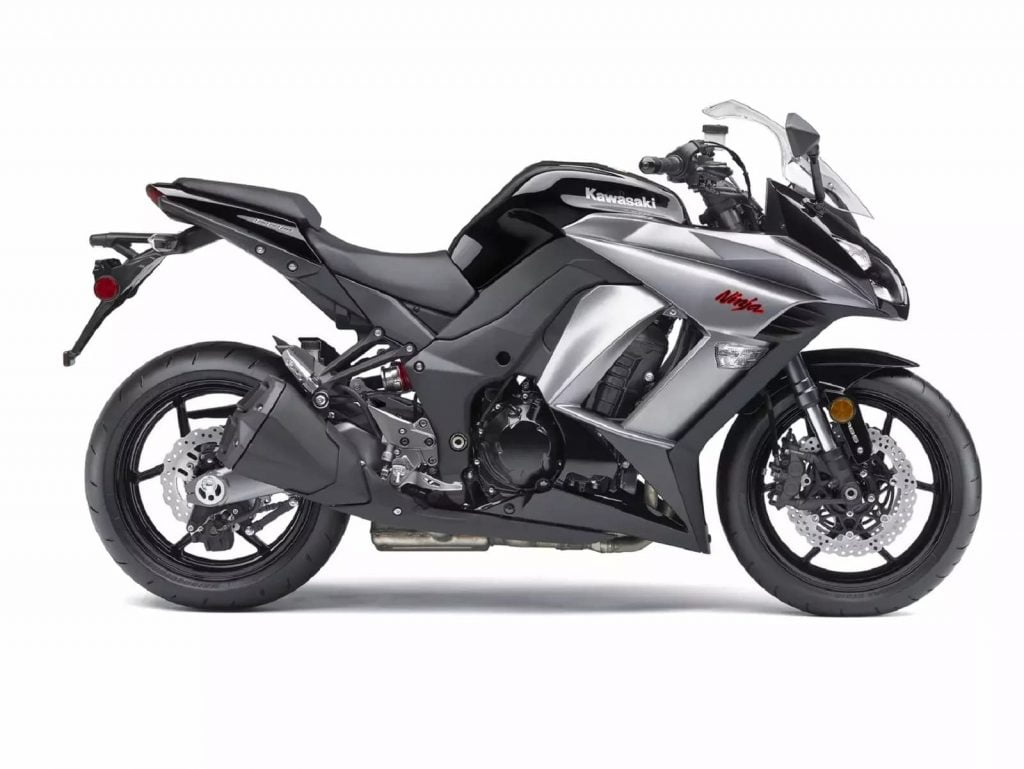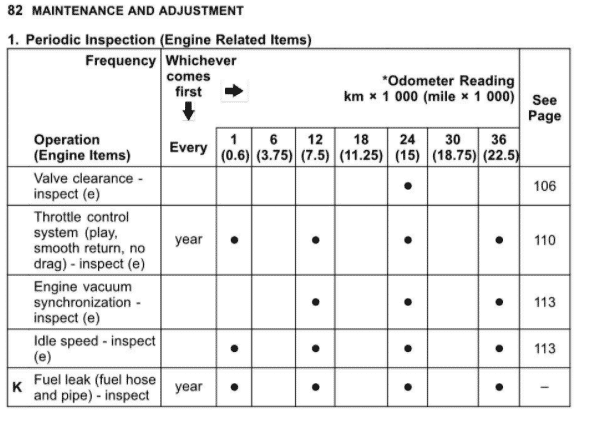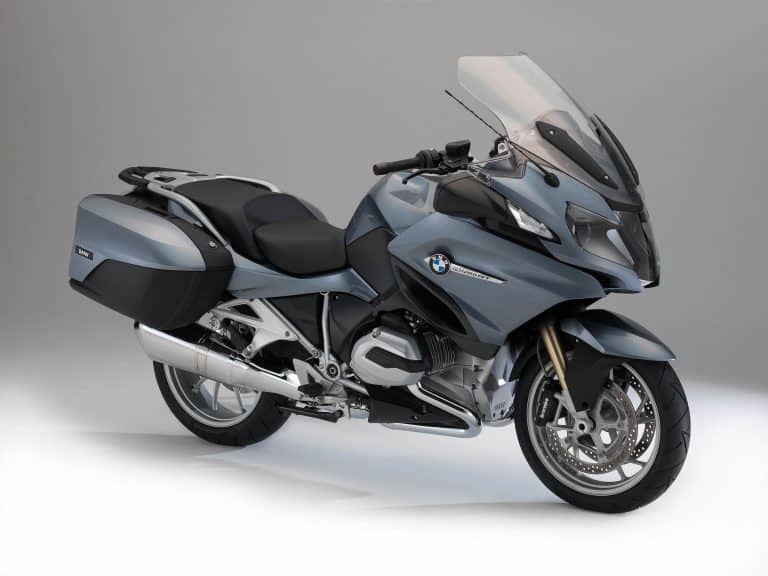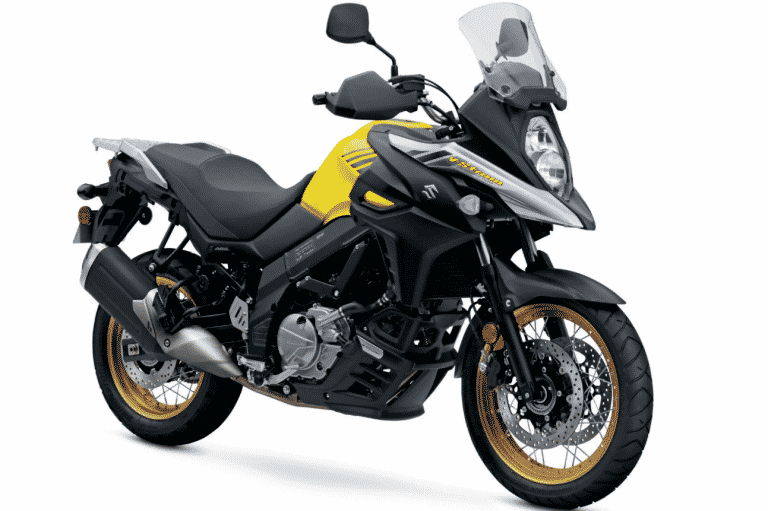Kawasaki Ninja 1000 (Z1000SX) Gen 1 (2011-13) Maintenance Schedule and Service Intervals
This is the maintenance schedule with associated service intervals for the Kawasaki Ninja 1000 Gen 1, also known as the Ninja 1000 ABS, Z1000S, Z1000SX, and Ninja 1000 SX. It was made between 2011 and 2013.
The Kawasaki Ninja 1000 is a sport-touring motorcycle released in 2010 and sold since model year 2011. It has evolved during the years, adding refinement, some power, and a lot of technology to it — becoming one of the early affordable motorcycles with a full 6-axis IMU for example.
It’s unrelated to other motorcycles in the Ninja range. The engine comes from the 2010 Z1000 and is similarly tuned for midrange performance. It’s a 1043 cc inline four-cylinder engine with dual overhead camshafts and four valves per cylinder. In the original Gen 1 incarnation, it made 101.5 kW (136 hp) at 9600 rpm, which didn’t change dramatically in subsequent generations.
Major generations of the Ninja 1000 were:
- Kawasaki Ninja 1000 Gen 1 (2011-2013): The base model, the 1,043cc sport touring bike we all love.
- Kawasaki Ninja 1000 Gen 2 (2014-2016): Enhanced Tokico brakes. Traction control, power modes, and optional ABS (standard in some parts of the world). Revised suspension, bodywork, and induction.
- Kawasaki Ninja 1000 Gen 3 (2017-2019): A 6-axis IMU giving it lean angle-aware ABS and traction control. Standard ABS, and new styling.
- Kawasaki Ninja 1000 Gen 4 (2020+): Ride by wire, cruise control, more ride modes, shortened trail, electronic suspension, revised tuning and camshaft profiles, an up/down quick shifter, a sweet colour TFT dashboard, and more changes.
Internally the Ninja 1000 didn’t change dramatically and always produced similar power output, even with changing emissions regulations.
This site has links for things like oil and spark plugs from which we earn a commission (which unfortunately nobody can save, not even us). If you appreciate this work, then please use those links. Thanks!
Kawasaki Ninja 1000 Service Intervals
Overall, the Kawasaki Ninja 1000 has 7500 miles / 12000 km or annual service intervals between oil changes. At every oil change, also change the filter.
Kawasaki recommends changing the spark plugs every 7500 miles / 12000 km (though not with a time component, like oil), and to check the valve clearances every 15000 miles / 24000 km.
Make sure you also regularly change the coolant and the brake fluid.
What you need to service the 2011-2013 Kawasaki Ninja 1000 Gen 1
To maintain the Ninja 1000 Gen 1, you need the following basic consumables, in addition to basic motorcycle maintenance tools.
| Part | Kawasaki Ninja 1000 Gen 1 Spec |
|---|---|
| Oil | You need 4.0L (4.2 US qt) of SAE 10W-40 engine oil “with API SG, SH, SJ, SL or SM with JASO MA, MA1 or MA2 rating”, preferably Kawasaki 10W-40 Engine Oil. Don’t over-torque the drain bolt (spec is 29 Nm/21 lb-ft per the manual) — use a torque wrench if you don’t have experience with how much torque is enough. |
| Oil filter | Oil filter is part 16097-0008, or you can use Hiflofiltro HF303RC. Torque for oil filter is 17 Nm (13 ft-lb) (use a torque wrench, and it’s easier on the Hiflofiltro one) |
| Front brake pads | Genuine part number for front brake pads is 43082-0113 for the Ninja 1000. Get double-sintered EBC brake pads for better bite and wear — code FA379HH. |
| Rear brake pads | Genuine part number for rear brake pads is 43082-0119. Get double-sintered EBC brake pads for better bite and wear — code FA192HH. |
| Spark plugs | NGK CR9EIA-9, with a spark plug gap of 0.8-0.9mm (use a spark plug gapping tool), torqued to 13 Nm or 9 ft-lb (use a torque wrench) |
| Air filter | Genuine part number is 11013-0712. You can also use the HifloFiltro part HFA2920. |
| Cable lubricant | Remember to lubricate your clutch cable (and brake cables if you have them) with a cable lubricant. Protect All Cable Life is a good general-purpose lubricant. |
| Chain lubricant | The chain needs to be lubricated every 600 km/400 miles (or more, if it gets wet/dirty). Motul chain paste is cheap and well-loved. |
| Brake fluid | Spec is to use DOT-4 brake fluid, like Castrol DOT 4 |
| Coolant | Use 2.9L (about 3.1 US qt) of “soft water and ethylene glycol plus corrosion and rust inhibitor chemicals for aluminum engines and radiators”, e.g. Valvoline Zerex G05 |
| Grease | Use a lithium soap-based grease for all the important greasing points. |
Maintenance Schedule for Ninja 1000 Gen 1
Below is the maintenance schedule for the 2011-2013 Kawasaki Ninja 1000 Gen 1. It is a list of maintenance operations and to be done on this motorcycle with a time or distance interval — whichever comes earlier.
Notes:
The maintenance for the Kawasaki Ninja 1000 Gen 1 was originally broken into many sections. But this was changed in later versions of the manual. Because it’s such a hard format to read, we’ve combined them into a more usable format.
- For higher odometer readings, repeat at the frequency interval below.
- Service the chain, air filter, and oil / filter more frequently when operating in severe conditions: dusty, wet, muddy, high speed, or frequent starting/stopping.
- Check the brakes and evap system more often than indicated — between services.
Kawasaki Ninja 1000 Service schedule
| km x 1000 | 12 | 24 | 36 | 48 | |
|---|---|---|---|---|---|
| mi x 1000 | Every | 7.5 | 15 | 22.5 | 30 |
| Maintenance checklist (see below) — Perform | year | ✓ | ✓ | ✓ | ✓ |
| Engine oil # – change (Kawasaki 10W-40 Engine Oil) | year | ✓ | ✓ | ✓ | ✓ |
| Oil filter – replace (HF303RC) | year | ✓ | ✓ | ✓ | ✓ |
| Air cleaner element # – replace (e) | 18000 km / 11250 mi | ||||
| Spark plugs – replace (NGK CR9EIA-9) | ✓ | ✓ | ✓ | ✓ | |
| Valve clearances – inspect | ✓ | ✓ | |||
| Evaporative emission control system – function check (if fitted) | ✓ | ✓ | ✓ | ✓ | |
| Air suction system damage – inspect | ✓ | ✓ | ✓ | ✓ | |
| Clutch operation (play, engagement, disengagement) – inspect | ✓ | ✓ | ✓ | ✓ | |
| Drive chain wear – inspect | ✓ | ✓ | ✓ | ✓ | |
| Drive chain guide wear – inspect | ✓ | ✓ | ✓ | ✓ | |
| Wheels/tires damage – inspect | ✓ | ✓ | ✓ | ✓ | |
| Tire tread wear, abnormal wear – inspect | ✓ | ✓ | ✓ | ✓ | |
| Brake pad wear – inspect | ✓ | ✓ | ✓ | ✓ | |
| Front forks/rear shock absorber operation (damping and smooth stroke) – inspect | ✓ | ✓ | ✓ | ✓ | |
| Rocker arm operation – inspect | ✓ | ✓ | ✓ | ✓ | |
| Tie rods operation – inspect | ✓ | ✓ | ✓ | ✓ | |
| Engine vacuum synchronization – inspect | ✓ | ✓ | |||
| Idle speed – inspect | ✓ | ✓ | |||
| Steering stem bearings – lubricate | 2 years | ✓ | ✓ | ||
| Brake fluid (front and rear) – change (Castrol DOT 4) | 2 years | ✓ | ✓ | ||
| Coolant – change | 3 years | ✓ | |||
| Radiator hoses and O-rings – replace | 3 years | ✓ | |||
| Brake hoses and pipe – replace | 4 years | ✓ | |||
| Rubber parts of master cylinder and caliper – replace | 4 years | ✓ | |||
| Fuel hoses – replace | 5 years |
Kawasaki Ninja 1000 Gen 1 — Maintenance checklist
| Maintenance checklist |
|---|
| Throttle control system (play, smooth return, no drag) – inspect Play: 2-3mm (0.08-0.12 in) |
| Fuel leak (fuel hose and pipe) – inspect |
| Fuel hoses damage – inspect |
| Fuel hoses installation condition – inspect |
| Coolant level – inspect (between lines) |
| Coolant leak – inspect |
| Radiator hose damage – inspect |
| Radiator hoses installation condition – inspect |
| Tire air pressure – inspect See below for tire pressure specs |
| Wheel bearings damage – inspect |
| Brake fluid leak – inspect |
| Brake hoses damage – inspect |
| Brake hose installation condition – inspect |
| Brake fluid level – inspect Inspect regularly, ensure it remains between lines |
| Brake operation (effectiveness, play, drag) – inspect |
| Brake light switch operation – inspect |
| Front forks/rear shock absorber oil leak – inspect |
| Steering play – inspect (no notches, smooth operation) |
| Lights and switches operation – inspect |
| Headlight aiming – inspect |
| Side stand switch operation – inspect |
| Engine stop switch operation – inspect |
| Chassis parts – lubricate |
| Bolts and nuts tightness – inspect |
Maintaining Your Chain on the Kawasaki Ninja 1000
It’s important to maintain your chain on the Ninja 1000, as on any chain-driven motorcycle, but particularly one that sees use in all kinds of conditions.
Kawasaki recommends you follow the following chain maintenance schedule:
| Chain maintenance item | Every |
|---|---|
| Check drive chain lubrication condition, lubricating if necessary (Motul chain paste) | 400 mi / 600 km |
| Check drive chain slack, adjusting if necessary Chain slack: 20-30mm (0.8-1.2 in) free movement in loosest part of chain | 600 mi / 1000 km |
Notes:
- Do these items (checking/adjusting slack, and checking/applying lubrication) more often if you ride your Ninja 1000 in dusty or rainy conditions.
- Always lubricate the chain after washing the motorcycle.
Tyre size and tyre pressure for the Kawasaki Ninja 1000
The 2011-2013 Kawasaki Ninja 1000 Gen 1 has the following tyres and tyre sizes standard, plus the following recommended tyre pressures.
| Tyre | Size | Brand(s) | Tyre pressure |
|---|---|---|---|
| Front | 120/70 ZR17 M/C (58W) | BRIDGESTONE BATTLAX BT016F BB | 250 kPa/36psi |
| Rear | 190/50 ZR17 M/C (73W) | BRIDGESTONE BATTLAX BT016R BB | 290 kPa/42psi |
About the Kawasaki Ninja 1000 Gen 1
The first gen Kawasaki Gen 1 shook up the sport touring market. It was (and still is, used) an affordable, high-power, extremely practical motorcycle that was lighter and faster than its immediate competitors.
Despite the presence of fairings and what looks like a sporty riding position from a distance, the Kawasaki Ninja 1000 is decidedly sport touring, with a comfortable riding position and options like a centre-stand and factory luggage. It competed mostly with the Honda VFR800, for example.
The Ninja 1000 was developed for the street rather than the track, so it’s tuned for strong mid-range power. Nonetheless, the Kawasaki is a fast bike, making around 100 kW (140 hp) from its 1,043cc engine.
As a “comfortable” sport bike, the Ninja 1000 completely dominated the Japanese sport touring segment since its inception, easily knocking the VFR800 off its pillar by being lighter, more powerful, and more pleasant to spend a whole day on (for most people). In fact, it’s mentioned by some as part of the reason the VFR800 is no longer available.
The Ninja 1000 is often thought of as a Kawasaki Z1000 with a fairing. Upright, comfortable, and with enough creature comforts to take you long distances, but much sportier than its sedate older siblings like the Versys 1000 or the Concours 14.
With an inline-four engine that makes over 100 kW (and around 140 hp) at the crank, the Ninja is not a low-powered bike. Crank the throttle and there’s a really nice intake roar that gets the juices flowing as rpms rise. Riders coming off a ZX-10R may miss the adrenaline rush of high-rpm power, but only when they’re REALLY pushing it.
The riding position of the Ninja 1000 is very comfortable. Not quite bolt upright, like you get on an adventure bike, but nearly there. The styling says “sports”, but the moment you put your hands on the clip-on handlebars, you know that you could ride this bike all day. In everyday riding it’s actually easy to forget, which is another way of saying it’s a little sedate and not as exciting as a sportbike… which doesn’t mean it’s not capable.
From the very start, the Kawasaki Ninja 1000 came with ABS in most markets either as an option or standard. This set a theme for the Kawasaki Ninja 1000 — it was always leading the way for Japanese sport tourers with technology, being the first to add an IMU in 2017, and the sport tourer to add cruise control in 2020 (if you don’t count the Tracer 900, which somewhat bridges the two).
Very little changed fundamentally with the Ninja 1000 over the years, though a few parts necessary for maintenance did change. Kawasaki also did significantly change the schedule for maintenance as emissions standards evolved.
These days a Kawasaki Ninja 1000 Gen 1 with low mileage is a very easy-to-find motorcycle for a low cost of entry — you can find them for less than half what they cost when they were launched. Since the engine stayed the same, this makes them a great entry point for sport touring.
In late 2011, the Ninja 1000 got a more touring-oriented big brother, the Versys 1000 — much the same engine but detuned for even more mid-range, in a heavier but much more comfortable chassis.
Manual for the Kawasaki Ninja 1000 Gen 1 (2011-2013)
The above maintenance schedule comes directly from the user’s manual for the 2011-2013 Kawasaki Ninja 1000 Gen 1, which is available here. There were no changes in the schedule during these years.
















